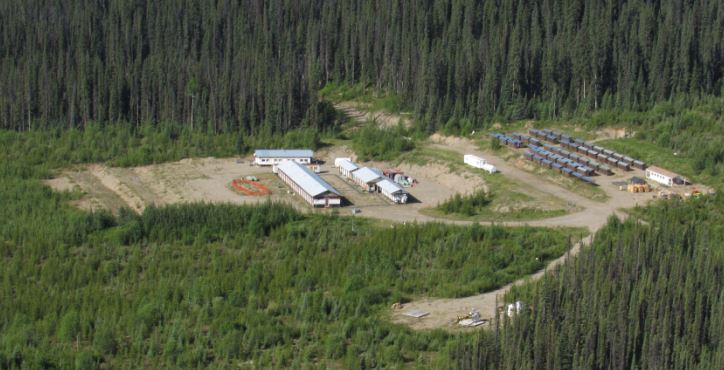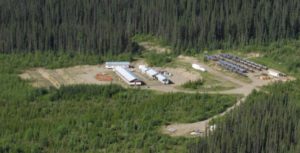ZincX Resources releasing Akie Project PEA

The ZincX Resources Akie Project exploration camp in the Kechika Trough, 260 km north-northwest of Mackenzie, northeastern British Columbia. Photo courtesy ZincX Resources Corp.
By Robert Simpson

Zinc miners predict by 2025 production will fall short by 4.3 million tonnes annually – an  opportunity not lost on Peeyush Varshney, CEO of British Columbia-based ZincX Resources Corp. [ZNX-TSXV].
“We are confident in the long-term fundamentals for zinc,” says Varshney who is exploring one of the largest untapped zinc-lead-silver districts in Canada.
The company’s Cardiac Creek deposit on the 100%-owned, 116 km2 flagship Akie Project in the Kechika Trough of northeastern BC has indicated and inferred resources of 5.3 billion pounds of zinc and 1 billion pounds of lead (at a 5% Zn cut off) making it one of the largest undeveloped zinc deposits globally.
Even more, the company holds a dominant land position with 11 different property blocks covering 682 km2 in the same geological district as the Cardiac Creek deposit and Teck’s Cirque deposit. ZincX owns 100% of eight of the 11 property blocks and maintains a significant, 49%, interest in the Pie, Cirque East, and Yuen properties with partners Teck Resources Ltd. [TECK.B-TSX; TECK-NYSE] and Korea Zinc Co. Ltd.
“Having a large partner with a deposit next door never hurts,” says Varshney.
Yet ZincX remains undervalued against its peer group. ZincX trades at $0.006 per pound of zinc compared to an average $0.021 per pound in the peer group. There are several explanations for the value gap. Predominant among them, ZincX and its projects are not widely known.
The company has for the most part raised capital through strategic shareholders like Tongling Nonferrous Metals Group Holdings Co. Ltd, Teck Resources and Korea Zinc Co. rather than through the traditional equity markets where analyst coverage and marketing support follows.
The company has changed its name twice. In 2005, it first became involved in the Akie Project as Mantle Resources which then, in September 2008, became Canada Zinc Metals. In May 2018, the company changed its name to ZincX Resources.
But the company’s anonymity may fade after the Preliminary Economic Assessment (PEA) for the Cardiac Creek deposit is completed shortly. If all goes as expected, the company should be on the radar screen of retail and institutional investors alike.
There are good reasons to be optimistic about the results of the PEA. The project is well-situated 240 km northwest of Mackenzie, BC in an established mining district. Infrastructure including highways, power, water, rail and port access is nearby. The company also has good relationships with the local First Nations built over almost 10 years and resulting in signed co-operation and exploration agreements.
Baseline environmental work is advanced and a significant amount of information has been collected over the last decade helping in the preparation of an environmental assessment application.
Recent metallurgical results were promising. Zinc is 89% recoverable into concentrate grading 52.4%, while lead was 46% recoverable into a concentrate grading 45%.
Most encouraging, however, geology of the Cardiac Creek deposit is proving to be richly endowed and widespread. After drilling 151 drill holes, the Cardiac Creek deposit appears to be a continuous zone 1,300 metres along strike and 800 metres down dip.
High-zinc grades have held up over the zones as well. At a 5% Zn cut off, the 22.7 million tonnes of indicated resources averages 8.32% zinc, 1.81% lead and 16.1 g/t silver. In the inferred category, there are 7.5 million tonnes grading 7.04% zinc, 1.2% lead and 12.0 g/t silver.
The next step for the company is to build a decline ramp and begin an underground drill program to better delineate the resource. The plans are to start raising the capital needed for an extensive underground program later in 2018.
ZincX is a company with depth. In addition to the Cardiac Creek deposit, it has 11 regional properties in the exploration pipeline. The Kechika Regional Project blocks, south to north, include: Pie, Cirque East, Yuen, Yuen North, Mt. Alcock, Kwad, Weiss, Bear/Spa, Driftpile South, Saint and Thro.
Exploration of the property blocks has been intermittent. Most recently, in 2006, drilling defined two significant occurrences of zinc-lead-silver mineralization on the Pie property. ZincX is also currently weighing the benefits of spinning off the Kechika Regional projects into another public vehicle.
